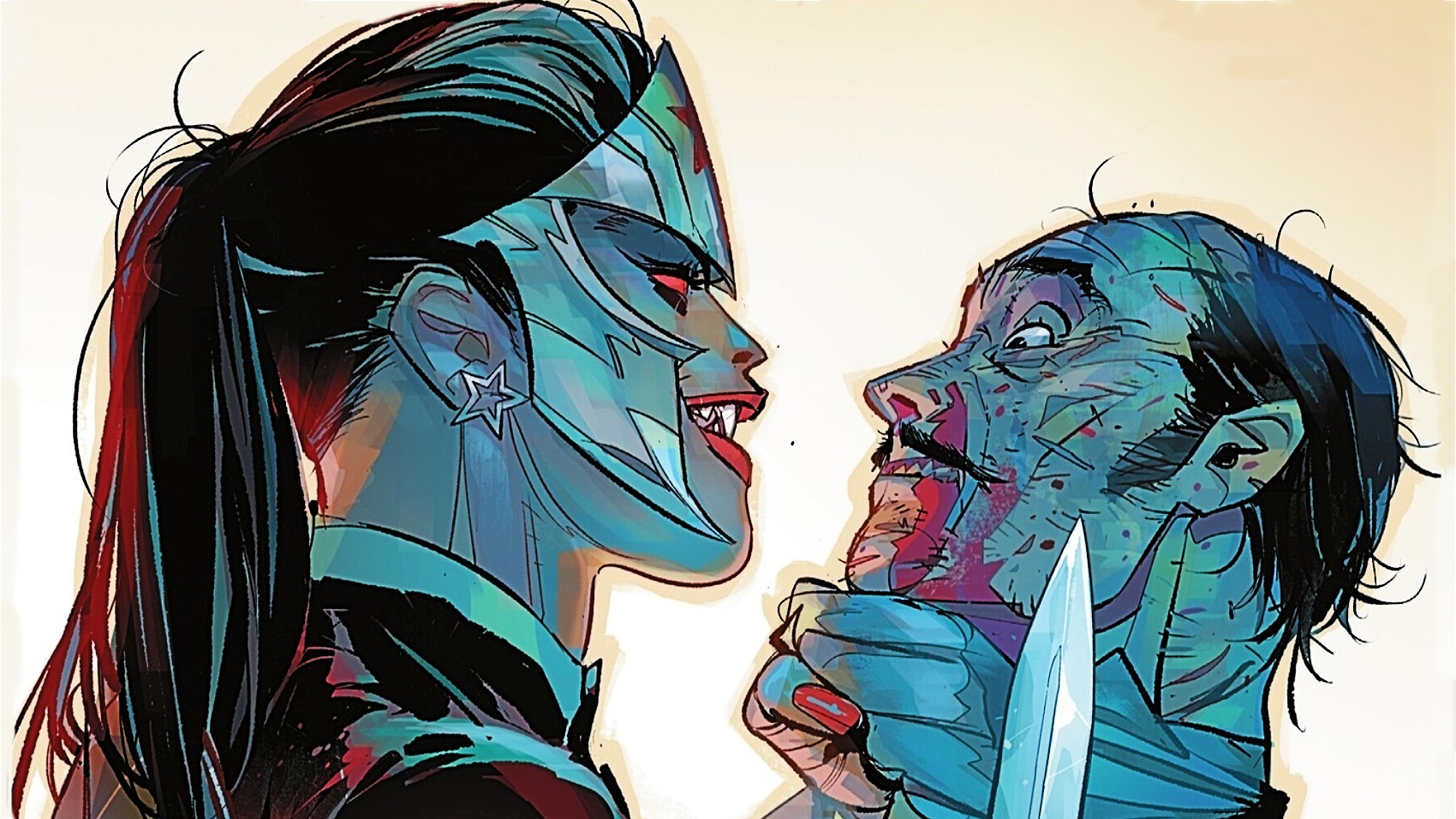The decision by DC Comics to bring the Elseworlds imprint out of retirement is proving to be a choice that was long overdue. Much like its earlier iteration, the return of Elseworlds has produced more than a few compelling storylines that are sure to eventually become DC classics. One standout new title generating no small amount of positive attention is Matthew Rosenberg and Otto Schmidt’s DC vs. Vampires. Embracing Elseworlds’ core principle of “out-of-continuity” exploration to the fullest, DC vs. Vampires is loaded with fascinating twists and interesting examples of beloved heroes being transformed into monstrous versions of themselves. Nowhere is this better demonstrated than with Wonder Woman.
In the story, Wonder Woman is turned into a vampire by an already transformed Hal Jordan’s Green Lantern. Once turned, she ascends the ranks of the vampire hierarchy in a way that is both captivating and controversial. While some fans appreciate the fresh take on exploring Wonder Woman’s darker side, others argue that her transformation feels awkward and inconsistent with her original character. This raises the question: Was turning Wonder Woman into a vampire a stroke of creative brilliance or a major misstep?
One of the more intriguing elements of the DC vs. Vampires series is the creative ways the story integrates a hero’s original powers with their new vampiric abilities. In the case of Wonder Woman as a vampire, the story is spot on. Rather than focus on the powers Wonder Woman already shares with vampires, such as superhuman strength and speed, immortality, and enhanced healing, the story instead emphasizes the mental changes that turning incurred on Wonder Woman. Indeed, as an Amazonian, Wonder Woman already has the bloodlust of a warrior, but when combined with a vampire’s voracious thirst for blood, she exhibited an overwhelming compulsion that helped morph her into a truly terrifying killer.
There was also her warrior’s code, which honored loyalty to one’s leader and teammates, a principle she demonstrated with brutal effectiveness throughout the series. Moreover, her position of power in the vampire leadership also rings true of her character. To be sure, vampire or not, Wonder Woman was always going to be at or close to the center of power. Ultimately, the series has effectively demonstrated how turning Diana into a vampire made her an even more formidable force.
Conversely, where the story fell flat was its depiction of how easily a centuries-old, battle-hardened demigod could be duped by a classic vampire mind trick and succumb to vampirism with almost no resistance. According to the series, after an already-turned Hal Jordan’s Green Lantern kills the Flash, Diana begins to suspect his involvement when he tries to “rizz” her near the site where the Flash’s body was discovered.
Wanting to uncover the truth, Diana uses her magic lasso to bind Jordan. This, however, proves to be a mistake. While the lasso compels Jordan to tell the truth, it also appears to make Diana more susceptible to believing his version of the truth. Jordan then uses his vampire hypnosis to deepen that susceptibility, ultimately convincing Diana to submit to his bite without a punch thrown.
Given her demonstrated mental toughness, discipline, and resistance to psychological manipulation, her rapid submission feels highly implausible. Furthermore, even after being bitten, Diana’s inability to resist her bloodlust or the commands of her vampire queen feels deeply out of character for Wonder Woman, a hero who is widely regarded as one of the foundational pillars of the DC Universe.
Elseworlds titles aim to provide fans with more creative options by granting authors and artists the license to reimagine characters and themes unlikely to be explored within the mainstream DC timelines. DC vs. Vampires, for instance, delves into the question of what would happen if heroes were transformed into vampires. Within this series, Wonder Woman offers a compelling example of both the advantages and disadvantages of alternate reality storylines.
On one hand, her transformation amplifies her power and presence, establishing her as an undeniable force in DC vs. Vampires, much like her original incarnation. This creative stroke of genius deepens her character’s portrayal across both realities. On the other hand, the circumstances of her turning and the ease with which she embraced her new vampiric state present a puzzling inconsistency. This could be seen as a form of character assassination, potentially dimming the luster of the Wonder Woman legend.
Naturally, reactions to such bold deviations can be divided, particularly as the story unfolds. However, at the very least, it casts the Princess of Themyscira in an entirely new light – and that perspective can’t be all that bad – from a fan’s perspective.
The decision by DC Comics to bring the Elseworlds imprint out of retirement is proving to be a choice that was long overdue. Much like its earlier iteration, the return of Elseworlds has produced more than a few compelling storylines that are sure to eventually become DC classics. One standout new title generating no small Read More

